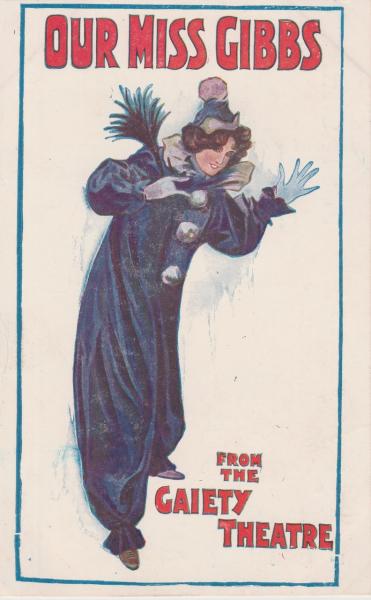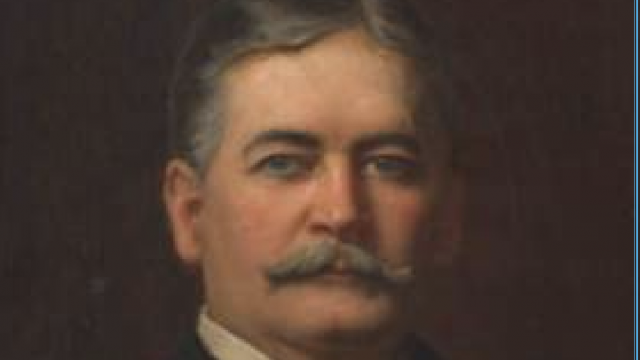Scouting for Shows
Australian producers have long trod the paths to the West End and Broadway to import plays and musicals for the local market. Impresario J.C. Williamson took such a trip in 1909. Archivist Susan Mills takes us on his journey, via his diary held by the Seaborn, Broughton & Walford Foundation.
On the 29th of June 1909, J.C. Williamson arrived in England on the Seydiltz steamer, having left Australia some 21 days earlier. He was met at Southampton by Pat Malone, the London representative of J.C. Williamson Limited, and taken to the Savoy Hotel. That evening he saw The Fires of Fate by Conan Doyle at the Lyric Theatre. He liked it, but wrote in his diary, “I doubt whether it would be any big success for Australia”.
J.C. Williamson was on a tour to scout for productions that ‘The Firm’, as the J.C. Williamson company was known, could take to Australia. He saw one or two shows every day, as well as holding business meetings.
It wasn’t all work. After three weeks in London he travelled via Paris to the fashionable German holiday spa town of Marienbad (now Mariánské Lázně in the Czech Republic). There he enjoyed carbonic baths, daily massages, and sightseeing. He saw a few local shows and hob-nobbed with many of the high society on holiday, including famed actor and theatre manager Sir Herbert Beerbohm Tree, with whom he spent a very pleasant day motoring through the countryside.
After visiting Munich music halls and Milan (where he auditioned a selection of opera singers for the J.C. Williamson Grand Opera Company’s upcoming season), he arrived back at the Savoy Hotel in London to resume his theatre-going before hopping on board the SS Kaiser Wilhelm II to leave for New York.
J.C. Williamson’s visit to New York also mixed the personal with business. His birthday on the 26th of August was spent lunching with his niece - and being interviewed by the New York Dramatic Mirror and the New York World - and by early September he was off by train to Chicago and Minnesota to visit family.
Arriving in Vancouver, Canada, he had a Turkish bath and saw a vaudeville show at the Orpheum (“a cheap Music Hall”) before boarding the RMS Makura the next day, bound for Australia, arriving at Brisbane on the 2nd of October 1909. His whole trip has lasted some four months.
Was his trip a success? Let’s look at the example of Our Miss Gibbs, an Edwardian musical comedy that was a great London hit, running for an astonishing 636 performances.
 After seeing the 7th of July performance at the Gaiety Theatre, J.C. Williamson wrote in his diary “A splendid performance. The piece is full of comedy [...] Certainly one of the best Gaiety pieces they have had. Packing the house, could not get a seat a month ahead, not even at the libraries. It is a certain success for us if we can get a good cast.”
After seeing the 7th of July performance at the Gaiety Theatre, J.C. Williamson wrote in his diary “A splendid performance. The piece is full of comedy [...] Certainly one of the best Gaiety pieces they have had. Packing the house, could not get a seat a month ahead, not even at the libraries. It is a certain success for us if we can get a good cast.”
The J.C. Williamson company’s Royal Comic Opera Company would open Our Miss Gibbs at Her Majesty’s Theatre in Sydney on the 24th of September 1910, and it was indeed a success. J.C. Williamson brought out English actress and singer Blanche Browne from the Gaiety Company to Australia for the role of Mary Gibbs.
Like its London predecessor, the Australian run of Our Miss Gibbs proved to have longevity. The day after the premiere, the Sunday Sun reported, “The J. C. Williamson management has every reason to congratulate itself on the striking success of Our Miss Gibbs, produced last night before a tremendous house in Her Majesty's Theatre” and praised the performance of the cast, the costumes and scenery. Our Miss Gibbs finally closed on the 10th of May 1911 in Sydney with its 230th performance. J.C. Williamson himself gave a speech before the audience, declaring the tremendous success of the production, which he said 389,720 persons had witnessed.
An interview with Blanche Browne in the Argus gives an insight into the actress at the heart of the show. The reporter remarks on the natural air of Miss Browne, perfect for the role of Miss Gibbs – “…it is difficult at times to remember which is which – whether Miss Mary Gibbs is ‘Our Miss Browne’, or Miss Blanche Browne ‘Our Miss Gibbs’.”.
Perhaps what comes across the most in the interview is her love of Australian nature and the quiet life, adding to the reporter’s conclusion that “there is nothing of the stage about her”. Indeed, Blanche Browne would stay on in Australia as part of the Royal Comic Opera Company until her marriage to a Tasmanian fruit farmer saw her settle into a quiet life.
After its Sydney run, Our Miss Gibbs opened at Her Majesty’s Theatre in Melbourne on the 13th of May 1911, where it ran until the 5th of August before embarking on a non-stop tour of Australia (except Western Australia) and New Zealand. Our Miss Gibbs returned to Melbourne for a Christmas season in early December of 1911, before finally landing in Sydney on the 26th of December for one last showing that ended on the 12th of January, 1912. The entire run of the Royal Comic Opera Company’s production of Our Miss Gibbs, from September of 2010 to January of 1912, was said to have broken records.
J.C. Williamson’s personal diary of his 1909 travels to England, Europe and northern America is held by the Seaborn, Broughton & Walford Foundation archive, and forms part of the ‘J.C. Williamson Distributed Collection’ registered on the UNESCO Australian Memory of the World Register. A document transcribing the diary with extensive annotations and a fully researched introduction has been completed by researcher John Senczuk and is available on the Foundation’s website.

